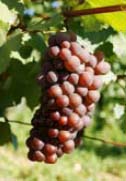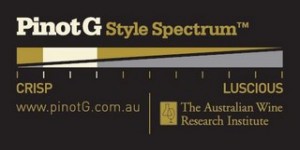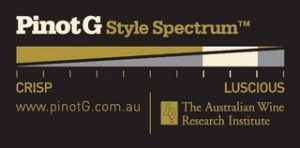Aussie pinot gris/grigio gets inside track on style
After three years of laboratory and organoleptic analyses, the Australian Wine Research Institute (AWRI) have launched a PinotG style spectrum, which aims to help consumers get an immediate grip on what style of pinot gris or pinot grigio is in the bottle.

Pinot gris/grigio
Pinot grigio and pinot gris (PG) are synonyms for the same grape variety, which in Europe tend to be associated with distinct regional styles. But in Australia it can be tricky to know whether you’re buying an Alsatian-style full-alcohol, dense, drily-luscious pinot gris, or a crisp, light, zesty northern Italian pinot grigio style, or even something with some overt residual sweetness.
At least Europe has those nominal, if increasingly blurry, broad origin and nomenclature clues. But in Australia, both pinot grigio and pinot gris are used interchangeably, which makes it extremely confusing for consumers.
The PinotG moniker neatly combines both synonyms in one abbreviation.
Spectral analysis
Three years of tasting panels built up a picture – a fingerprint – of different styles of PG. In defining those differences across a style spectrum, the scientists and tasters found differences in such wine constituents such as flavour molecules, phenolic compounds and acids.
Spectral analysis was used to analyse the components tasted. This involves shining a beam of light at the wine, analogous to x-raying wine. Correlations were found between the machine readings and the tasting panels’ assessments, and thus the style spectrum was born.

PG style spectrum 2
Peter Godden, group manager – industry applications, at the AWRI, and one of the key developers of the style spectrum explained the detail, saying “you have to ‘train’ the [machine]. If, say, you want it to ‘measure’ alcohol, then you test a group of wines for ethanol using the reference laboratory method, and you also scan those wines and tell the instrument what the result of the reference analysis was. The calibration is ready when you can show the instrument an ‘unknown’ sample, and it will accurately predict the alcohol. In the case of the PinotG style spectrum, we believe it is a world-first where spectral scans have been calibrated against sensory ratings for wine style, rather than for alcohol, pH, colour etc.”
So with ‘fingerprinting’ individual compounds are not being measured. Godden said this is not the purpose of the style spectrum. It’s the overall flavour sensation and palate profile that are important.
And the analysis is still being refined, as new information from different PG wines are added to the spectral analysis machine to hone and polish the detail of the calibration. Godden said: “We are still adding to the calibration – the more data it contains, the better its predicative capacity will be – so we are doing both sensory evaluation and the spectral scan for each wine – but for virtually all the wines the predicative ability is excellent. For those which are not so closely correlated it is simply a case that wines with that type of ‘fingerprint’ are not currently in the calibration. Once they are included, then they can be predicted.”
Dry and off dry wines only

PG style spectrum 8
The style spectrum is a ten-point scale, from crisp to luscious, encompassing dry and relatively dry wines up to a maximum of 10g/l residual sugar. This incorporates the vast majority of PG wines sold in Australia, and, Godden explained, “if one included sweet wines, for example SGNs, [sélection de grains nobles from Alsace] at the right hand side, you could end up with, say, 60, 70, 80% of the graphic being reserved for the sweet wines which are a tiny part of the market, and the drier wines which make up the bulk of the market being compressed into a small space”. This would make it difficult to see stylistic differences at the dry end of the scale, which, added Godden “would have defeated the purpose for the majority of Australian wines.”
So whilst luscious sounds like it ought to suggest something sweet, in fact the dictionary says it is ‘extremely pleasurable, especially to the taste or smell.” In the context of the PinotG style spectrum, it describes a PG wine that’s rich, dense, opulently textured and weighted.
The first wines to carry the logo are the 2010 vintages from Treasury Wine Estates (the name by which Foster’s global wine business has been known since July 21, 2010) and Aussie retailers Cellarmasters, with whom the spectrum has been developed.
Other producers will follow on with the 2011 vintage, and any producer wanting to use the voluntary scheme to help consumers understand the style of their PGs must submit their wine for ‘fingerprinting’ by the AWRI.
Even without access to a simple style scale, and perhaps influential in its development, PG has shot up in popularity in Australia. Pinot grigio/gris plantings may account for just 4% of Australia white vineyard area, but they have increased dramatically. In 2006, just 1,352ha were planted and by 2008 (most recent data available), plantings had reached 2,835ha [Australia Bureau of Statistics].
In Germany the grape variety is also known as grauburgunder and rülander.
Comments
2 Responses to “Aussie pinot gris/grigio gets inside track on style”




September 20, 2010 at 3:56 am
Hi Sally
Thanks for this informative analysis of the style spectrum. I was introduced to the concept when travelling through the Mornington Peninsula in May this year in preparation for writing my book “In Search of the Perfect Pinot Gris: Mornington Peninsula”.
Kevin McCarthy mentioned this style spectrum when I interviewed him. I’d already been very conscious of the style differences which was one of the things that prompted my decision to write the book in the first place.
Do you see this concept catching on?
Do you agree there is a need to try and identify the wines so the consumer is not confused at time of selection?
September 20, 2010 at 8:47 am
Hello A.B, Some sort of style/sweetness indication on the label for both pinot gris/grigio and riesling would, I think, be enormously helpful for consumers. If it could be something internationally agreed, even better I reckon. I want to know if I’m buying a dry wine or something medium dry. Different expectations, different flavour profiles, different usage occasions. It’s too easy to end up disappointed and not buying that wine from that producer again. I don’t see an absence of style indicator as being any good for the producer or the consumer. Glad you like the article.